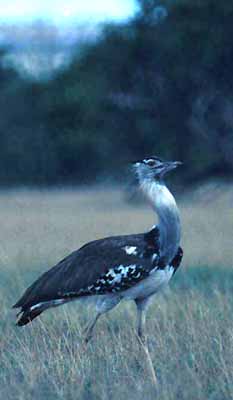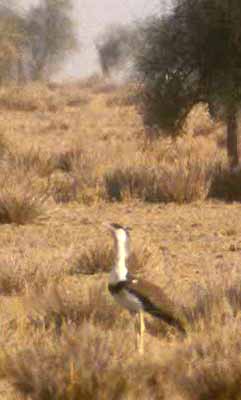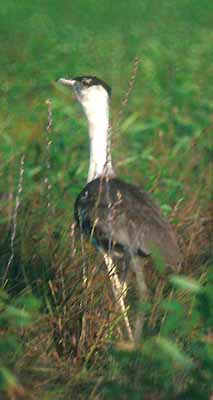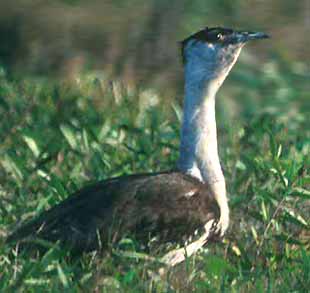 I've always had a fascination with bustards, those strange, gangly, and
long-necked birds of the Old World grasslands. And among the bustards are
three huge ones in the genus Ardeotis: the Kori Bustard A.
kori of Africa, the Australian Bustard A. australis of
Australasia (left), and the Great
Indian Bustard A. nigriceps of the Indian subcontinent. Each
stands up to 3.5 ft tall and can weigh up to 30 pounds -- these are just
HUGE birds. [The one other species in the genus, Arabian Bustard A.
arabs, is very interesting in its own right but is decidedly smaller.]
These three big bustards resemble each other closely. Indeed, from an amateur
geographer's point of view, it seems obvious that they must have had the
same ancestor that ranged from Africa to Australia in some long ago era
only to become isolated by major environmental changes. They now exist
in three widely separated grasslands as shown on the map
below. Because they are such big birds, they require substantial
wild habitat to survive. All have declined with fragmentation of arid grasslands.
[My naive "obvious" viewpoint may not be correct; according to Collar (1996)
it is nigriceps and australis that are closely related with
kori
more aligned with arabs than with the other two.] In any event,
I've always wanted to be able to say I'd observed all three in the wild.
Now, after a March 2001 trip to India, I can finally do so.
I've always had a fascination with bustards, those strange, gangly, and
long-necked birds of the Old World grasslands. And among the bustards are
three huge ones in the genus Ardeotis: the Kori Bustard A.
kori of Africa, the Australian Bustard A. australis of
Australasia (left), and the Great
Indian Bustard A. nigriceps of the Indian subcontinent. Each
stands up to 3.5 ft tall and can weigh up to 30 pounds -- these are just
HUGE birds. [The one other species in the genus, Arabian Bustard A.
arabs, is very interesting in its own right but is decidedly smaller.]
These three big bustards resemble each other closely. Indeed, from an amateur
geographer's point of view, it seems obvious that they must have had the
same ancestor that ranged from Africa to Australia in some long ago era
only to become isolated by major environmental changes. They now exist
in three widely separated grasslands as shown on the map
below. Because they are such big birds, they require substantial
wild habitat to survive. All have declined with fragmentation of arid grasslands.
[My naive "obvious" viewpoint may not be correct; according to Collar (1996)
it is nigriceps and australis that are closely related with
kori
more aligned with arabs than with the other two.] In any event,
I've always wanted to be able to say I'd observed all three in the wild.
Now, after a March 2001 trip to India, I can finally do so. |
|||
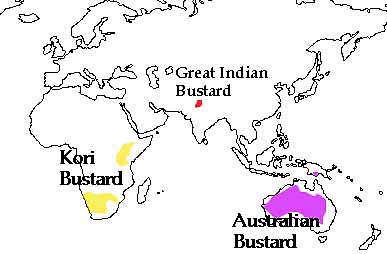 |
|||
And now I can finally show photos of these three great big bustards
side by side (L to R: Kori, Indian, Australian).
|
|||
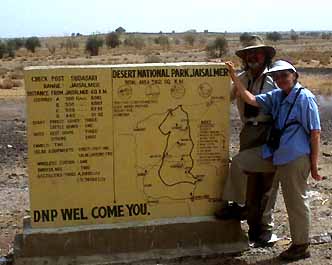 The Great Indian Bustard is classified as Endangered because of
its very small, declining population, a result of hunting and continuing
agricultural development (Birdlife International 2000). It has entirely
disappeared from five Indian and Pakistani states, and less than 20 birds
remain in four other Indian states. Only tiny populations (<100) exist
in Andhra Pradesh and Maharashtra, so the last stronghold of the species
is in the arid semi-desert of extreme western Rajasthan, India. The largest
protected area set aside for this highlight bird is Desert National
Park (left; that's Rita Carratello and me posing at the entrance sign).
That population is estimated at perhaps 500 bustards. Their ecology has
been studied here to some extent, and there are rangers to try to protect
the reserve from poaching.
The Great Indian Bustard is classified as Endangered because of
its very small, declining population, a result of hunting and continuing
agricultural development (Birdlife International 2000). It has entirely
disappeared from five Indian and Pakistani states, and less than 20 birds
remain in four other Indian states. Only tiny populations (<100) exist
in Andhra Pradesh and Maharashtra, so the last stronghold of the species
is in the arid semi-desert of extreme western Rajasthan, India. The largest
protected area set aside for this highlight bird is Desert National
Park (left; that's Rita Carratello and me posing at the entrance sign).
That population is estimated at perhaps 500 bustards. Their ecology has
been studied here to some extent, and there are rangers to try to protect
the reserve from poaching. |
|||
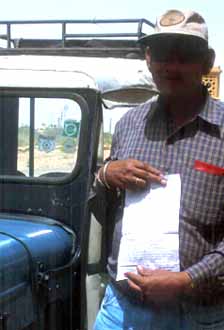
It is not easy to visit Desert National Park. Located on the border with Pakistan it is in a highly secure zone operated by the Indian military. A permit is required to go there, and obtaining the permit is a bureaucratic nightmare. The steps necessary are outlined by Kazmierczak & Singh (1998). They involve visiting three offices during working hours (avoiding the long break at lunch time) in Jaisalmer, the nearest city to the national park, and obtaining the proper papers. The visitor has to physically sign a logbook at one of the offices. The process can take 1-3 days according to various reports posted on the Internet. During our visit to India in March 2001, we hired Raj Singh's company (Exotic Journeys, Ltd.) to provide the drivers, lodging, and permits. Our guide in western Rajasthan was Manhedra Singh and he was superb. He seemed to be related to everyone in town, including the official at one office and the hotel owner of our lodgings at Hotel Rawal Kot. He managed to obtain the priceless permit (okay, actually there is a price to be paid for the permit also) in two hours (!) on a hot dusty afternoon (Manhedra and the permit; right). [You can read more about our India trip and Raj Singh's company at the link.] It is a two hour drive by jeep from Jaisalmer to Desert Nat'l Park, so we got an early start. Unlike the rest of India where the roads are crowded with buses, bicycles, camel carts, and herds of goats and it takes forever to get anywhere, the roads here have almost no traffic because of the military restrictions. The road is also nicely paved for some distance (again, for army reasons) and one most check in at the police station at Sam at about the halfway point. From there the road is a broad dirt track running south to the park. We were greeted by very helpful park staff who reside in mud huts baked hard in the desert sun. The habitat stretches out to the horizon in all directions but the best habitat is looking back to the east (photo below top) where a huge swathe of semi-desert has been surrounded by a fence to keep out cattle. One arranges with the local wardens to be escorted on a walk into the desert looking for the Great Indian Bustards (below bottom). |
|||
 |
|||
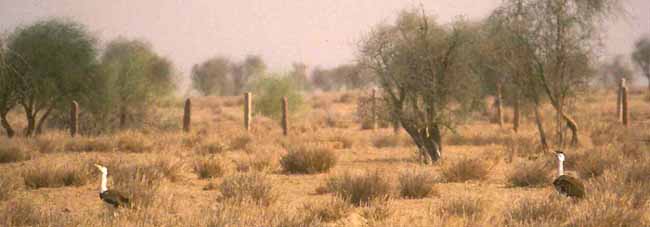 |
|||
| We managed to see seven bustards in loose association during our visit.
The first one was actually flushed by a pack of feral dogs that were harassing
Indian Gazelles Gazella bennettii, known locally as Chinkara. [Indian
Gazelle is often lumped with Dorcas Gazella Gazella dorcas which
ranges west to the Sahara.] Once the bustards flew quite a distance from
the dogs they settled down in to stride slowly through the open savanna
among clumps of short grass. They were very wary; Dan Singer and I had
to slither Army-style through a series of sand dunes to obtain even these
distant photos. [This is also the classic habitat for another endangered
species -- the
White-browed Bushchat Saxicola macrorhyncha -- and Rita found
one of these; click on the link to see photos and read more.]
Although setting aside reserves and reducing poaching has helped the Great Indian Bustard, more effort is needed. The birds undergo nomadic movements -- sometimes for quite a distance -- in response to a variety of factors that are not well understood. The habitat itself is fragile and drought is a recurring problem. Great Indian Bustards can breed at any time of year but it is usually initiated by the start of the rains. Those annual rains are thus important to population stability. While we were there, the staff seemed very intent on protecting these magnificent birds and we left with a feeling of hope. Political instability remains a feature of subcontinental politics, of course, and these birds on the Pakistan border are in a particularly flammable locale. We felt fortunate to enjoy our experiences and can only hope for their continued existence in the future. |
